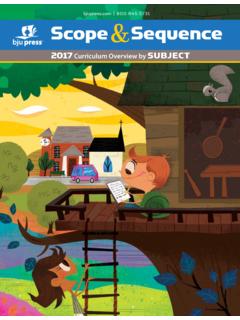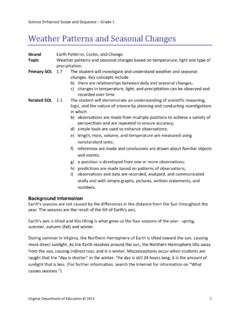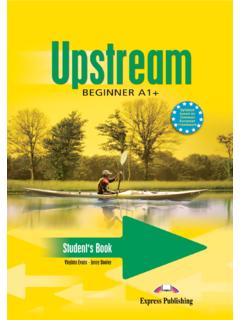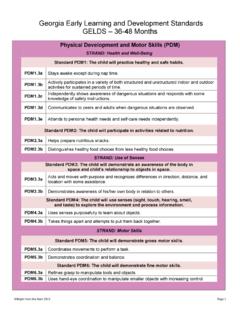Transcription of Robert Matthew - First Peoples' Cultural Council
1 HandbookLanguage and Culture Immersion ProgramsPhoto: Robert Matthew AcknowledgementsThis handbook was created by the First Peoples Heritage, Language and Culture Council LanguageProgram. First Peoples Heritage, Language and Culture Council (FPHLCC) has strongly supported First Nationslanguage and culture revitalization and maintenance projects in British Columbia ( ) since 1990. Language and Cultural immersion has proven to be the most successful method for the transmissionof language and culture from generation to generation. For this reason, language and culture im-mersion camps, where participants are surrounded by their traditional culture and language, arehighly valued in First Nations communities.
2 The Ministry of Aboriginal Relations and Reconciliation (MARR) and New Relationship Trust (NRT)provide support and funding, allowing FPHLCC to distribute language and culture immersion campgrants to many First Nations communities. In addition, FPHLCC provides ongoing support tocommunities with program planning, development and reporting. FPHLCC is working towards improving and making the language and culture immersion camp grantprogram more accessible for First Nations communities. This handbook is intended to be apractical tool for elders, community members, teachers and anyone else involved in language andculture immersion camps.
3 It includes tips for language teaching and learning, ideas for languageimmersion games and activities , as well as suggested language teaching methods. FPHLCC Language Program Handbook Development TeamXway Waat (Deanna Daniels), Language Program CoordinatorHannah Amrhein, Applied LinguisticsWe respectfully acknowledge support and funding for this project fromMinistry of Aboriginal Relations and ReconciliationNew Relationship Trust original basket by Martha Fred image created by Alex WadsworthContentsFive Language Learning Principlespg 3 Five Tips for Language Immersion Activitiespg 3 Simple Language for Beginnerspg 4 Daily Conversation Repetitionpg 5 Daily Activitiespg 6 Outdoor Activitiespg 9 Oral Language Gamespg 10 Cultural Knowledge Activitiespg 11 Arts and Craftspg 12 Nine Tips for Successful Language Teaching/Learningpg 13 Five Methods and Approachespg 15
4 Referencespg 162 Five Language Learning PrinciplesLearning a language requires patience from teachers and from learners. Language is learned by speaking it; give learners lots of chances to speak. Repetition is crucial; the more language a person hears, the more they learn in many different ways at different is essentially used for communication, and the goals of language teaching should be to allow learners to communicate in the language. Five Tips for Language Immersion ActivitiesAny activity can be turned into a language learning opportunity. A good way to help learners pick up words and phrases is to have learners repeat actions, words and immersion does not include is always more successful when it is fun and enjoyable.
5 Feel free to create your own games and activities based on your own program!3 Photographer: Jan Miettinen-Hart Simple Language for BeginnersIn the beginning, it is important for learners to be able to follow simple instructions and understand basic phrases. If learners can understand a few of the basics, they will feel more comfortable andlearning will come language for instructions Learners can always participate by following :Saying Hello Learners need to be able to use simple questions and greetings. examples:4stand upsit downcome herego backbe quietgive me the _____turn rightturn leftwhere is the _____?
6 Jumpput your hands upfold your armscross your legsturn aroundlie downput _____ backleave _____ aloneclaplooklistenspeaksmellonetwo ..hellogoodbyehow are you?I am finewe are fineyesnomaybethank youhave a good dayDaily Conversation RepetitionWhen the same simple conversations are repeated each day several times, they will become ingrainedin learners minds and they will never forget -Learners can introduce themselves to the group by using set : Questions and answers fluent speakers can ask and repeat questions that follow a set pattern. examples: 5my name is am from father s name is mother s name is am _____ years love my is this?
7 This is a colour is this?it is old are you?I am _____how do you say _____?what is this for?it is for is the _____?it is are you from?I am from _____what am I doing?Photo: Karen Borsato Daily ActivitiesLanguage is naturally learned through daily activities . All daily activities can be carried out in your First Nations language. In a language immersion camp, phrases and words can be easily learned through daily routines with fluent Learners can pick up words and phrases related to eating, food items, meal preparation,cleaning up and mealtime conversations. examples:examples:6are you hungry?yes, I m very hungryno, I m not hungrydo you like___?
8 This is deliciouscan I have somemore?how was your meal?come and eatI m fullserve the foodeat all your foodthe food tastes goodwould you like more?no thank youyes pleasepass the saltwash the dishesclear the tabledry the disheswipe the tableput the dishes awaybreakfastlunchdinnerfeasteatkitchenh elpinghungrythirstyfullovenstoveguesttha nk you washingcookdrinkfoodknifeforkbakefrypotp anspoonplatebowltablechairdishesDaily ActivitiesRoutines -Learners can pick up words and phrases related to getting up in the morning, gettingdressed, going to bed, personal hygiene and the :examples:7are you tired?brush your teethget dressedI m tiredmake your bedit s time to wake up it s time to go to bedgood morning!
9 / good night!did you have a good sleep?wash your hands and facewhat s the weather like today?the weather is good todayit s cold/hot/sunny/rainy/snowy/windy todayhow do you feel today?I feel good todayearlylateawakeasleeptiredweathersun cloudrainskypantsshirtdressskirtshoessoc ksunderwearhatjacketvestbodyheadeyenosem outhearhairstomacharmhandfingerlegfootkn eeteethsoapwashfaucettoilettodaytomorrow showertowelwet/drybedblanketpillowcombto othbrushbathroomPhoto: St at mic gathering Daily ActivitiesChores Learners can participate in daily chores such as chopping firewood, cleaning and gardening. From these chores learners can learn many new words and phrases.
10 Examples:examples:Plans for activities Learners and fluent speakers can have simple discussions about plans forthe day involving family, friends and : 8chop the woodpull the weedswater the plantswash the dishesclean the housetoday we need to _____can you help me?is it too heavy?carry the woodstack the woodfirewoodplants (differentnames)gardenweedswaterclean/di rtyheavyhelpcarrystackliftwashtreeflower soapscrubbrushcollectfloordishesroomwind owsweepcome/gowhat are we going to do today?let s go for a s go visit do you want to do?is it a good idea?do you want to go ____?let s go togetherlet s play a gamewhere are we going?







